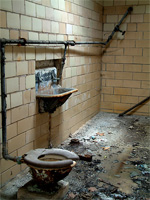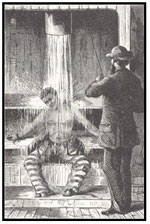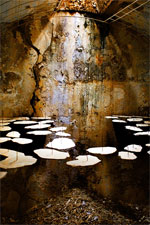
"No prisoner is seen by another after he enters the wall. When the years of confinement have passed, his old associates in crime will be scattered over the earth, or in the grave and the prisoner can go forth into a new and industrious life, where his previous misdeeds are unknown." - The Quakers concept that helped spawn The Eastern State Penitentiary; one of the most haunted buildings in America. Though it is now a tourist attraction, back in it’s opening in 1829 to it’s closing in 1971 it was one of the most feared penitentiaries that drove many to madness and saw numerous deaths.
History
 In 1822 construction of Eastern State Penitentiary began, the architect John Haviland had used the ‘hub and spoke’ design - which allowed easy viewing of each cellblock from the center that had been popular in Europe, a design that would be used in 300 different penitentiaries. It was to use the Quaker’s concept where Prisoners would live in small cells with no human contact other than the occasional visit from a guard. Each cell had running water, heating and a functional toilet -
Something that was uncommon for it’s time; The prisoners were to spend 23 hours of the day in this cell, only to be let out to his personal exercise yard; Even the rare occasion they were allowed to leave their cell they had a hood placed over their head so they could not see anything or be seen by other prisoners. In 1822 construction of Eastern State Penitentiary began, the architect John Haviland had used the ‘hub and spoke’ design - which allowed easy viewing of each cellblock from the center that had been popular in Europe, a design that would be used in 300 different penitentiaries. It was to use the Quaker’s concept where Prisoners would live in small cells with no human contact other than the occasional visit from a guard. Each cell had running water, heating and a functional toilet -
Something that was uncommon for it’s time; The prisoners were to spend 23 hours of the day in this cell, only to be let out to his personal exercise yard; Even the rare occasion they were allowed to leave their cell they had a hood placed over their head so they could not see anything or be seen by other prisoners.
Gloom was always in the air with no materials (other than the bible) to occupy one’s mind and with very little light that came through a slit in the prison ceiling dubbed ’The Eye of God’, It was no wonder why so many prisoners attempted to communicate, knowing very well what the risks of being caught were. In the early years if a prisoner was caught trying to communicate, whistle, sing or even talk to themselves they were deprived of dinner; Repeated offenders were taken to a punishment cell and were given very little bread and water. Over time the punishments became ghastly when the prison staff began to experiment. The most common punishments they used were the Iron Gag, the Water Bath, the Straitjacket, the Mad Chair and The Hole.
The Iron Gag was the most common and the most feared. It was a device that was clamped onto the tongue while his arms were crossed and chained behind the neck. Any movement resulted in the gag tearing on the tongue causing extreme pain. The prisoners mouth would be bloody and sore when released, if they lived through the torment.
 The Water Bath was a punishment that was known at many mental hospitals around the time. It involved dunking or drenching an inmate in ice cold water then chain them to a wall for the night. The more brutal guards enjoyed doing so in the winter months, so the water would freeze onto the inmates skin.
The Water Bath was a punishment that was known at many mental hospitals around the time. It involved dunking or drenching an inmate in ice cold water then chain them to a wall for the night. The more brutal guards enjoyed doing so in the winter months, so the water would freeze onto the inmates skin.
The Straitjacket was used in a different way than the normal. Instead of being put in the straitjacket to keep the inmate from harming himself or others they were bound in the jacket till they passed out from the lack of blood flow, which would leave them numb and black for awhile afterwards.
The Mad Chair - called so due to the fact many inmates had gone mad before the punishment was over was another idea taken from mental institutions. The inmate would be chained and strapped into a chair so tightly they would be unable to move even a muscle. The duration of this punishment varied from a few hours to a few days. Their bodies would become sore and swollen from lack of circulation, making them unable to walk or move for hours (even days) after being placed back in their cell.
The hole was dug under block #14, it was nothing but a pit where uncontrollable inmates would be locked for long periods of time, in some cases even weeks. No light was in the hole, little air came though and if the inmate was lucky, they would be thrown a little water and bread - which the horde of rats and roaches would fight the inmate for.
As to be expected, with such harsh punishments and strict living many inmates mental health was deteriorating. With such isolated conditions insanity was common. The prison doctors often invented reasons for the outbreaks that never involved the isolation. Many cases blamed excessive masturbation and that inmates went crazy because of their genes. Another problem that continued till the closing of Eastern State was the numerous escape attempts. The first escape came in 1832 when inmate number 94 - William Hamilton - was serving dinner in the warden’s apartment.
When the warden had stepped out for a moment, William managed to tie several sheets together and climb out the window - When he was finally caught in ‘37 he was returned to his old cell. Another memorable near-escape was in 1826 when eight inmates took turns making a tunnel under cells 24 and 25; they had tunneled almost 35 feet before discovered. In 1945 a group of prisoners actually succeeded in making a tunnel using wood from the prison shop as reinforcements. When it was completed the men left at slightly different times to avoid being caught; The guards had caught the last two climbing out and the others were apprehended only a few blocks away.
Soon Eastern State became the most famous prison in America and tourists from all around came to visit. One of the most famous tourists was author Charles Dickens who visited during his five month tour of America in ‘42; he claimed it was a necessary destination, right after Niagara Falls. He would later write about his trip in 1845 saying "the system here is rigid, strict, and hopeless solitary confinement... I believe it, in its effects, to be cruel and wrong." He also went on to write about how the treatment of the prisoners was "torturing of the mind that is much worse that any physical punishment that can be administered."
By the 1870s the method of total solitary confinement was abandoned and was considered a large failure due to it’s lack of results. It was decided that Eastern State would become a regular prison. More cells were built, the personal exercise yards were also turned into cells. Due to overcrowding the original cells were renovated to be able to hold up to five men instead of just one. Extra buildings were built as well, and a wood shop and education programs were added to help not only the prisoners but Eastern State as well, selling the goods inmates made helped fund Eastern State for years.
In 1924 Pennsylvania Governor Gifford Pinchot had sentenced Pep ‘The Cat-Murdering Dog’ to a life sentence at Eastern State, The story was Pep had murdered the governor’s wife’s cat. Pep was even assigned an inmate number - C2559. It was reported that the governor donated his own dog to the prison to increase morale and the cat murdering story was more so a publicity stunt.
 In May of 1929 Al Capone and his bodyguard Frankie Rio had slipped town to avoid heat that was still coming for the bloody events of the St. Valentine’s Day Massacre in Chicago when sentenced to a year in prison on charges of carrying concealed weapons, Soon they found themselves in Eastern State. Though Capone was in prison his business continued, he was given a private cell and was given permission to make long-distance phone calls from the wardens office; He was also allowed to meet with his lawyers and with Frank Nitti, Jack Guzik and his brother Ralph, all of whom would visit often.
In May of 1929 Al Capone and his bodyguard Frankie Rio had slipped town to avoid heat that was still coming for the bloody events of the St. Valentine’s Day Massacre in Chicago when sentenced to a year in prison on charges of carrying concealed weapons, Soon they found themselves in Eastern State. Though Capone was in prison his business continued, he was given a private cell and was given permission to make long-distance phone calls from the wardens office; He was also allowed to meet with his lawyers and with Frank Nitti, Jack Guzik and his brother Ralph, all of whom would visit often.
His stay at Eastern State was far more comfortable than other inmates; an article in the Philadelphia Public Ledger for August 20, 1929 described his cell "The whole room was suffused in the glow of a desk lamp which stood on a polished desk.... On the once-grim walls of the penal chamber hung tasteful paintings, and the strains of a waltz were being emitted by a powerful cabinet radio receiver of handsome design and fine finish..." It was during his incarceration in Eastern State that Capone first began to be haunted by the ghost of James ‘Jimmy’ Clark, one of the St. Valentine’s Day Massacre victims and the brother-in-law of his rival Bugs Moran. Many inmates reported that they would often hear Capone screaming in his cell begging for Jimmy to go away and to leave him alone. Even after his release he claimed Jimmy would continue to haunt him till his death.
Talk began amongst the inmates in the 1960’s about Eastern State’s closing. The building was collapsing in areas, and walls were crumbling, it would cost nearly as much to build a new prison as it would to renovate Eastern State. By 1970 Pennsylvania Governor Shafer announced that four new prisons would be built to replace Eastern State. Construction began immediately and by ‘71 most of the men were transferred to Graterford. On April 14, 1971 Eastern State was empty. It wasn’t till the New Jersey State Prison riots that Eastern State opened it’s doors once more for eight months then it stood empty yet again.
The Encounters
Although the cells of Eastern State were empty of prisoners they were not empty of lost souls. For what ever reason it be, the souls of former residents still linger the halls of Eastern State. Maybe it’s because they could never find their way out, or maybe they stay behind because of their traumatic departures from life. Numerous volunteers’ and visitors alike have had experiences that still give them chills. Even before the closing of the prison stories would float around from inmates and guards of supernatural activity. Whispers, laughter, weeping and the eerie sound of pacing feet are anything but uncommon within the walls.  "The idea of staying in this penitentiary alone is just overwhelming... I would not stay here overnight," stated Greta Galuszka, a program coordinator for the prison.
"The idea of staying in this penitentiary alone is just overwhelming... I would not stay here overnight," stated Greta Galuszka, a program coordinator for the prison.
One of the more common claims is the sound of echoing laughter in Cell Block 12. Another is shadowy apparitions in the cells and halls, who dart across corridors and vanish into rooms. The phantom is the most common of these sightings though - he is described as being a dark, human-like figure who stands still and quit till you get too close, then he darts away into the darkness. Every person who has ever encountered the phantom state that he gives off a feeling of anger and malevolence.
A locksmith named Gary Johnson was performing some restoration work one day when he had an encounter that would make him shudder in fear years after. "I had this feeling that I was being watched," he stated, "but I turned and I’m looking down the block and there’s nobody there. A couple of seconds later and I get the same feeling... I’m really being watched! I turn around and I look down the block and shoooom.... this black shadow just leaped across the block!" Gary refers to the prison as a "giant haunted house."  Another spirit that is frequently seen is a ghost that stands high above in a guard tower. It’s believed that the spirit belongs to a guard that was murdered by an inmate while on watch. Why would a guard who was free to leave stay standing his post after death is a mystery many have wondered.
Another spirit that is frequently seen is a ghost that stands high above in a guard tower. It’s believed that the spirit belongs to a guard that was murdered by an inmate while on watch. Why would a guard who was free to leave stay standing his post after death is a mystery many have wondered.
In a given year two dozen different paranormal investigations take place at Eastern State and according to the Assistant program Director Brett Bertolino, they almost always find evidence of activity.
The Stats – (Where applicable)
• Style of Haunting: Apparitions
• Top 100 Ranking: 46
• Location: Philadelphia, Pennsylvania
• Date Location Was Constructed: 1822
|